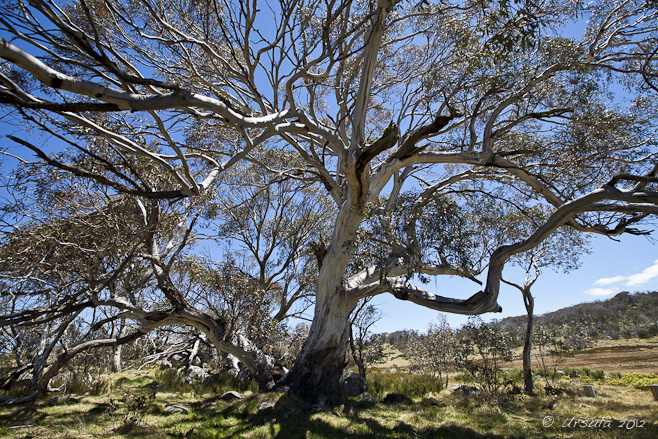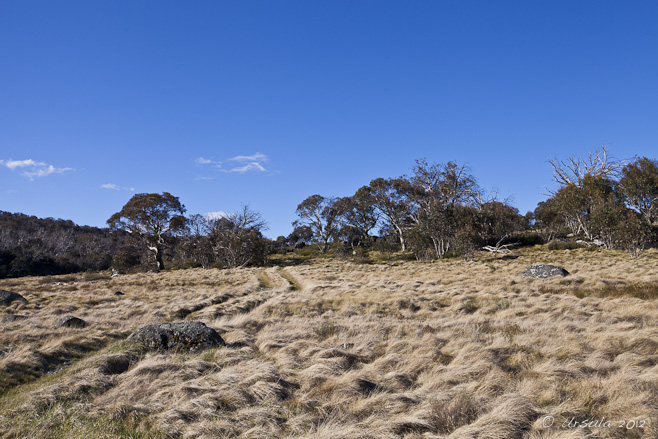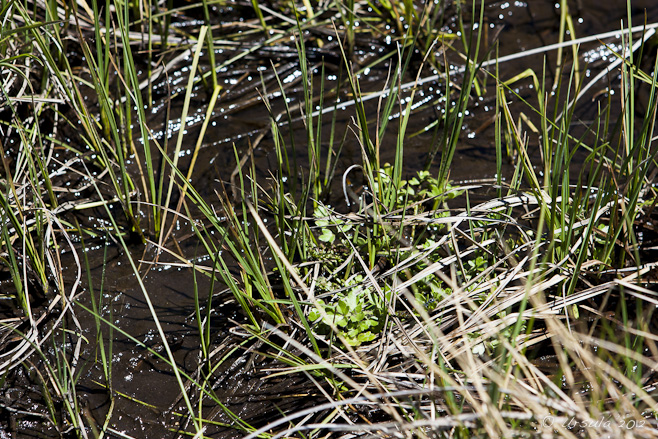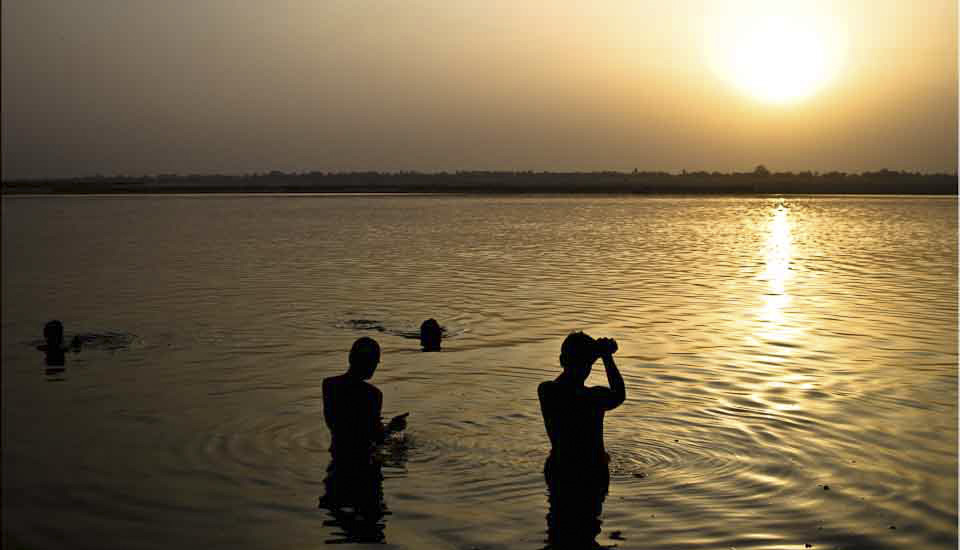 Snow Gums
Leaning, spreading, snow gums provide a modicum of shade over the car park at Rennix Gap. One of the many beauties of Kosciuszko National Park in Australia’s alpine Snowy Mountains, is the assortment of walking trails. This makes it easy to find a walk to suit the weather, one’s mood, and the abilities of any walking companions.
The 6.5 kilometre walk from Rennix Gap to a Snowy Hydro radio repeater station, high on a ridge, is not a track I follow often. Although it is a pleasant 4-5 hour walk out and back, there are some moderately challenging inclines, and the lower areas can be very boggy and wet. When I have guests, I usually pick an easier walk or one with more dramatic views.
Having said that, the Rennix Walk is the first place I ever spotted the vibrant flame robin, or saw an echidna in the wild, and the track winds through some very pretty landscape. It was a sunny afternoon in early November – that is: late spring in the antipodes – the last time my husband and I decided to make the trek.
 Rennix Walk follows an old management trail and starts by crossing grassy flats.  You need to stay on the track: the ground is boggy and wet – especially after the snow melts of spring.  Got the essentials? Hat, sunscreen, water, bug spray, and we might want the walking sticks on the hills.  Sawpit Creek winds its way through the boggy plain.  The trail climbs up through bush and snow gums and past giant granite boulders.  The “bridge” over Stewarts Creek comprises some well-weathered boards.  From Lakes Creek Saddle there are views across the wetlands to Kosciuszko’s Main Range.  The alpine plants and snow grasses spring to life in the ground water soaking down from the surrounding hills.  The bark of the stately snow gums is always a work of natural abstract art.  Fallen trees are part of the cycle of the landscape.  The Reddish Bog Heath (epacris glacialis) [I think?] has just started blooming.  The walk rises up and crosses gorse-filled clearings.  The Leafy Bossiaea (bossiaea foliosa) [I think?] has also started to flower.  I have no idea what the growth at the base of this tree trunk is, but it made for some interesting textures.  The top of Giants Castle affords great views, but the ascent is only recommended for experienced climbers.  From a safer rocky vantage point, there are nice views of Lake Jindabyne, far below.  The landscape in the other direction stretches out over the Snowy River and up to the Main Range.  The next granite outcrop, which to me looks like a pair of rabbits, signals that we are close to the apex. The top of the walk is marked by a rather un-photogenic repeater station, which sits atop more granite boulders. Again, the climb can be a little challenging, so we opted for a short sit and a muesli bar before returning back the way we had come.
 Snow Daisies (brachyscome nivalis) are scattered across the ground.  Alpine Rusty-Pods (hovea montana) stand out against the alpine grasses.  Once we are back at Lakes Creek Saddle, we know it is all a gentle walk downhill.  White Purslane (neopaxia australasica) dots the granite-strewn path as we head back to the car.  Rennix Gap was named for W.E. Rennix, an engineer and surveyor who died after being caught in a blizzard in the area. We were much more fortunate: I lost (and found) my mobile phone, the boggy ground took its toll on the soles of my favourite old hiking boots, and we returned to the car a little wet and worn out. Rennix Gap was named for W.E. Rennix, an engineer and surveyor who died after being caught in a blizzard in the area. We were much more fortunate: I lost (and found) my mobile phone, the boggy ground took its toll on the soles of my favourite old hiking boots, and we returned to the car a little wet and worn out.
In short, it was an enjoyable afternoon, and we were able to bask in self satisfaction as we clinked our glasses over dinner that evening.
To your health!
Pictures: 11November2012
Posted in Australia,Nature,TravelTags: alpine,blog,flowers,Kosciuszko,National Park,nature,Photo Blog,Rennix Walk,travel,Travel Blog,Ursula Wall,walk
 Sacagawea and Baby Jean Baptist
Sculpture by Glenna Goodacre (b. 1931), Buffalo Bill Historical Center, Cody, WY The Wild West is a place of legends and stories…
Few are more moving than that of Sacagawea (Bird Woman), the Lemhi Shoshone woman, kidnapped in 1800 by a raiding party of Hidatsa when she was about 12, and a year later, given or sold, along with another young captive Shoshone girl, to Toussaint Charbonneau, a French Canadian trapper. Thirty-four year old Charbonneau was hardly a prime catch: six years earlier he had been stabbed by an old Saultier woman for raping her daughter.
In 1804, Lewis and Clark hired Charbonneau as an interpreter for their expedition to explore the Western United States, because Shoshone-speaking Sacagawea was part of the deal. She gave birth to her first child, Jean Baptist, February 11, 1805, before the expedition set off, and the child travelled with her across the country. “Meriwether Lewis called [Charbonneau] “a man of no peculiar merit”.” Sacagawea, on the other hand, so impressed Lewis and Clark when she rescued their journals, records and other materials from the Missouri River after a boat capsized, that they named the Sacagawea River in her honour.
In American popular history, Sacagawea is an integral part of the Lewis and Clark story: in the early twentieth century, the National American Woman Suffrage Association adopted her as a symbol of women’s worth and independence; in 2000, the United States Mint issued the Sacagawea dollar coin in her honour; and in 2001, then-president Bill Clinton gave her the title of Honorary Sergeant, Regular Army.
I suppose if I were an American, I’d have know more about Sacagawea before visiting Wyoming – in the Wild West, the place of legends and stories…
 Watch for Fallen Rock
The road out of Yellowstone National Park and into the rest of Wyoming lead us through a magnificent rocky landscape.  Like a scene out of a Western movie, rocky outcrops overwhelm the road. We have arrived in frontier country. We found a motel in Cody, Wyoming, and parked our little sedan next to the Harley Davidson motorcycles and Mack trucks in the car park. Taking the desk clerk’s advice on eateries, we headed down the road to Cassie’s Roadhouse, a typically western-looking bar with a cowboy on a bucking bronco in neon over the front door… and a huge parrot on the sign over the drive-in entry.
Here we learned about another woman who managed to succeed against the odds. Cassie Welsh moved to Cody with her father and married a local engineer in 1907. He died shortly thereafter, so she opened a “Ladies of the Night” house in central Cody. She later moved to the current Roadhouse on the West Strip, where she owned and ran the genteely-named Cassie’s Supper Club until her death in 1952. She is fondly remembered locally as “a lovely lady who always helped people”.
The parrot became a trademark of the next owners, who had brought two live birds from Brazil – as one does.
The restaurant was full when we arrived, and rather than wait we decided to sit in the bar, next to the wooden dance floor where two couples were about to practice. I thought we might be up for some line-dancing or a country two-step, but no! On Tuesdays, the local dance champion and instructor gives free lessons; next thing we knew, we were brushing up our cha cha. In Wild West Cody!
It was far too much fun, and we never made it to the city’s nightly rodeo.
The next morning, we allocated some time to visit the Buffalo Bill Historical Center.
Not enough time, as it turns out. It is for good reason that the entry ticket is valid for two days: the complex of five museums in one building has been described by The New York Times as “among the nation’s most remarkable museums.” (Edward Rothstein, New York Times, August 3, 2012).
 Grizzly Bear
We entered the Buffalo Bill Historical Center through the Draper Museum of Natural History which depicts various aspects of the Greater Yellowstone area. We found it fascinating after having just been in the National Park itself. Enter the ultimate Wild West legend: Buffalo Bill Cody, a name synonymous with the history of the American West.
He was born William Frederick Cody in 1846, of Quaker parents. From 1853, his family lived in Kansas, where they were regularly persecuted for their outspoken anti-slavery stance. When Cody was 11, he became the main breadwinner after his father died of complications from injuries inflicted by a pro-slavery supporter. He worked, first as a “boy extra” – a message runner – for a freight carrier, then as a scout during the Utah War, where he gained his reputation as a an “Indian fighter”.
Cody’s colourful career is a mix of fact and “spin”. He earned his “Buffalo Bill” nickname by killing 4,280 American Bison in only 18 months (1867–1868) while he was contracted to the Kansas Pacific Railroad to supply them with meat for their workers. Not long after, Ned Buntline’s serialised stories and dime-novels turned a loosely fictionalised version of “Buffalo Bill” into a national folk hero.
By age 26, Cody had been awarded a Medal of Honor for “gallantry in action” while serving as a civilian scout. The same year, he made his stage debut in The Scouts of the Prairie, one of Buntline’s original Wild West shows. During the 1873–1874 season, “Wild Bill” Hickok joined Cody and “Texas” Omohundro in a new play called Scouts of the Plains.
Ten years later Cody founded his own “Buffalo Bill’s Wild West” show, which was staged, in one form or another, across the US and in Europe until 1908. Looking through the exhibits and memorabilia, I was amazed at the breadth and depth of performers he engaged. Fancy riders from all over the world; Western figures whose names I recognised, like Calamity Jane and Annie Oakley; Native Americans like Sitting Bull. Buffalo Bill’s troupe was successful at popularising “The West” in the US and Europe, making his persona an American icon and an international celebrity.
Like other figures who are larger than life, Cody’s legacy is a mixed one. Although responsible for thousands of buffalo deaths, he actively supported conservation, spoke out against hide-hunting, and pushed for a regulated hunting season. He was known as an “Indian fighter” but he respected Native Americans and their rights. He is quoted as saying: “Every Indian outbreak that I have ever known has resulted from broken promises and broken treaties by the government.” He was castigated as a drunkard, a fraud, a bad businessman and a racist. But while he made and lost fortunes, he was generous to a fault. He supported women’s rights and payed them, and the Native Americans and foreign nationals in his traveling show, according to merit, not race or gender.
He died in 1917, a Western legend – but almost broke.
The city of Cody, and it’s wonderful museum, is only a small part of his contribution to the American West.
 Scout’s Gear
Long hair, to protect the eyes and ears; long coat for warmth; and long rifles for more accurate, powerful shots at enemy or game.  Hon. W.F. Cody Uniform and Saddle  “The Buffalo Bill Combination”
Western showmanship: Props from one of Buffalo Bill’s shows.  Annie Oakley’s Gloves
Costume from one of “Buffalo Bill’s Wild West” shows.  Luxury Tenting
View inside an American Army Scout’s base-camp tent, Buffalo Bill Historical Center.  Portable Tent
Smaller tents were used for scouting forays. Cody called Native Americans: “the former foe, present friend, the American”.
The Plains Indian Museum section of the Buffalo Bill Historical Center depicts the history and culture of Native Americans, while highlighting their place in modern America.
 Dog Soldier Feather Bonnet
Visitors examine the exhibits in the Plains Indian Museum section of the Buffalo Bill Historical Center.  Plains Indian Tent  Ancient “New World” Corns  Beaded Papoose Carriers  Woman’s Work
A Plains woman on horseback, with a travois.  Cowrie-Shell Embellished Dress
Quill working, hide painting and bead working demonstrated women’s skills, and their pride and love for their families.  Man’s Cape  Fury ~ Man and Horse  Buffalo Bill
The sculpture of a very dapper Bill Cody outside the Buffalo Bill Historical Center bids us good-bye.  Wolf Howling
Another enduring symbol of the American West… Reluctantly, after a great lunch in the cafeteria, we set off, out of the Buffalo Bill Historical Center, out of Cody, and east – out of Wyoming…
 Wyoming Prairies and Mesa  Highway I-14 East  Shell Creek
The low point, before the rise into the Bighorn Mountains.  Into a Snow Cloud
The road through the Bighorn Mountains disappears… Middle of summer, but they say it’s going to snow tonight!  We stopped at a forlorn off-season mountain resort before descending the other side of the Bighorn Mountains. When we finally managed to attract some service, our waitress rued the “miserable climate” and the likelihood of summer snow. She was fed-up, homesick and California dreaming… We stopped at a forlorn off-season mountain resort before descending the other side of the Bighorn Mountains. When we finally managed to attract some service, our waitress rued the “miserable climate” and the likelihood of summer snow. She was fed-up, homesick and California dreaming…
The Wild West is not for everyone.
‘Till next time!
Pictures: 15August2012
Posted in America,Biography,History,LandscapesTags: America,arts and crafts,blog,Buffalo Bill,Buffalo Bill Historical Center,First Nation,history,museum,Native American,nature,people,Photo Blog,Plains Indian,sculpture,travel,Travel Blog,Ursula Wall
 Castlegregory Beach
One of Ireland’s longest beaches: from Cloghane Village to the Maharees and Castlegregory. Rain.
It was day nine of our walk around the Dingle Peninsula last June, and once again we woke up to rain.
Soft, misty, Irish rain – but coat-soaking, bone-chilling, camera-splattering rain even so. Not my idea of beach weather! My walking boots were still wet from crossing bogs the day before, so the overcast skies had me feeling less than cheerful.
According to our trip notes, we were up for a 29 kilometre walk, with 11 kilometres of it (or 11 miles – depending on whom you believe) along Castlegregory Beach. In the rain.
Day 9: Cloghane to Castlegregory
A long but not a demanding day, dominated by Irelands longest beach, with fantastic views of both sea and mountains and the off shore Maharees Islands.
Local birds include seabirds (several species of seagull, shags, cormorants, gannets to name but a few), larks, starlings, curlews, crows, ravens, garden birds such as sparrows, robins and finches, and wading birds such as the heron. The swallow is a frequent visitor in the summer months, all to be seen on this walk.
Distance: 29 km/18 miles, Ascent: 40m/120 ft
 River Owenmore
Everything was fresh – and wet – as we set out on our walk from Cloghane, Ireland.  Castlegregory Beach
One small patch of blue beckons us as we start our traverse along the beach skirting Brandon Bay.  Textures
Wind whips up the wet sand over the creatures stranded by the last high tide.  Castlegregory Beach
Two hours into our walk, the skies start to clear, lifting our moods, and completely changing the colour of the landscape.  Gull Taking Off  Seagulls Wading
Large European Herring Gulls (Larus argentatus) congregated in groups at the water’s edge.  Seagull in Flight  Seagulls in the Surf
A Lesser Black-backed Gull (Larus fuscus) wades at the water’s edge.  Sand Dunes
A lot of our walk was past dunes covered in hardy marram grass.  A Tuft of Grass
European Marram Grass or Beachgrass (Ammophila arenaria) clings to the windy sand-scape.  Nature’s Still-Life: Pebble Drift  As we approach the north end of the beach, black clouds roll in …  … slanting the light low over the dunes …  Windsurfer
… and darkening the skies over the hamlet of Fahamore (An Faiche Mór or “the large green”).  Oystercatchers
Eurasian Oystercatchers (Haematopus ostralegus) are meant to be common in this area; these were the first we saw.  Body Surfers
Young people in their wetsuits seem unconcerned about the incoming clouds. Once we reached the little hamlet of Fahamore (An Faiche Mór) at the north end of Brandon Bay, we took a break at the charming – and apparently “famous” – Spillane’s Bar & Restaurant. We were more than ready for a late lunch and early libation: there is nothing like a little stroll in the sea air to sharpen the appetite!
The next stretch of walking took us across Scraggane Bay, then back south along Tralee Bay towards Castlegregory.
 Pied Wagtail (Motacilla alba yarrellii)  Boats on Scraggane Bay
A small fleet of fishing boats, netting European lobster, spiny lobster or crayfish, spider crab, edible crab, and Atlantic salmon, keeps this area alive.  Rusty Cart
The other economic mainstay is farming: mostly root vegetables, which love the sandy soil.  A young bull watches us pass.  Like a Commercial!
It must be dinner time: the horse seems to be racing the car across the Maharees Peninsula.  Kilshannig Graveyard
The crumbling graveyard at Kilshannig includes an ancient (seventh century) cross slab.  Rocky Coast
The beach on the east of the Maharees Peninsula, along Tralee Bay, is covered in sharp rocks.  Fish Traps
Traps for lobster or crayfish are scattered around Tralee Bay. 
The overcast had lowered again and the skies were almost dark by the time we stumbled into Castlegregory, our home for the night.
It had been, as our trip-notes had promised, a “long but not a demanding day”: a wonderful walk with some great scenery.
So, I was happy: my camera chips were full… and my boots were finally dry.
Sláinte!
Pictures: 27June2012
Posted in Ireland,Landscapes,Nature,TravelTags: beach,blog,boats,Dingle Peninsula,Ireland,nature,Photo Blog,rural,The Dingle Way,travel,Travel Blog,Ursula Wall,walk
 Into the Woods
It’s a pleasant walk around the grounds of Westminster Abbey, Mission, BC. Kermit the Frog lamented on the difficulties of being green.
It’s not that easy bein’ green
Having to spend each day the color of the leaves
When I think it could be nicer being red or yellow or gold
Or something much more colorful like that
It’s not easy bein’ green
It seems you blend in with so many other ordinary things
And people tend to pass you over ’cause you’re
Not standing out like flashy sparkles in the water
Or stars in the sky
It may not be easy being green, but I always feel better when I am surrounded by it.
During our too-brief stay in some smaller communities in Canada’s forested and green British Columbia last July, we took advantage of the wilds on our doorsteps, and walked out into the woods whenever we could.
While staying in Mission, a small city on the north bank of the Fraser River, about 60km inland from Vancouver, we visited the nearby Benedictine monastery of Westminster Abbey.
 Westminster Abbey, Mission, BC The order was established in 1939, and construction of the abbey, church, and seminary, all designed by Norwegian architect, Asbjørn Gåtheat, started at this site in 1953. The monks took up residence the next year.
During the school term, the Abbey is home to the only Anglophone high school seminary in Canada and a college degree program. While we were there, however, the church was padlocked tight, and the grounds were quiet. We saw one small group of visiting religious – perhaps escorted by one of the 30 resident monks.
 Orange-Red Berries  A damp climate with plenty of dark, green places, means slugs can usually be found.  The abbey grounds provide a commanding view up the Fraser River Valley.  A group of visitors inspect some of the grounds’ 70 hectares.  Pine Cones From the Abby, it is not far to Rolley Lake Provincial Park, which – in the words of their own website – “provides a quick escape from urban life”.
Lakeside Loop, around Rolley Lake, provided us with with a delightful walk through more green…
 Rolley Lake  A boardwalk section of the Lakeside Loop skirts over wetlands.  Once Were Woods…
Anything could be lurking – it’s like something out of a Brothers Grimm fairy tale!  Mossy Woods
If you get lost, just remember that moss grows denser on the north side of trees.  Spanish Moss  Woods and Clear Waters  Tumbling White Waters  Dead Leaves  More Moss  Rolley Lake is a popular kayaking, swimming and fishing spot. A few days later, we had the chance to wander some of the seven kilometres of trails that criss-cross Cliff Gilker Park in Roberts Creek, on BC’s Sechelt Peninsula. We walked well-maintained spongy trails through Douglas Fir and Red Cedar trees, climbed stairs, clambered over rocks and crossed charming bridges over Clack and Roberts Creeks.
 Small Waterfall, Cliff Gilker Park  Evergreen Trees  Spanish Moss on Lowered Branches  Textures: The Bark of a Douglas Fir (Pseudotsuga menziesii)  Small Red Berries  Salmonberry – Rubus spectabilis  Even the Mighty Fall!  Cedar and fir both have beautifully straight, tall tree trunks.  Fallen Log and Water Falling Thanks to Joe Raposo‘s lyrics, Kermit comes to grips with being green:
But green’s the color of Spring
And green can be cool and friendly-like
And green can be big like an ocean
Or important like a mountain
Or tall like a tree
When green is all there is to be
It could make you wonder why
But why wonder, why wonder?
I am green and it’ll do fine
It’s beautiful!
 And I think it’s what I want to be! And I think it’s what I want to be!
I’m glad – because I love it.
Photos: 25July 2012 and 28July2012
 Phothudaw (ဖိုးသူတော်) – Acolyte
Mahagandayon Monastery, Amarapura It is a different world…
Temples and monasteries are an integral part of life in Myanmar. They accommodate about half a million males, who are either vocational monks or novices, and around 50,000 nuns. That is: roughly one percent of the population actually lives in one of the many monasteries or nunneries, completely dependent on the laity for all their material needs.
Theravada Buddhist monastic life has a strict daily routine revolving around prayers and religious study, but it is the silent alms-rounds (e.g. Sangkhlaburi, Chiang Rai, and Luang Prabang) and the mealtimes (e.g. Lining up for Lunch) that fascinate outsiders and which provide such rich photographic opportunities.
 The Morning Shave
Mahagandayon Monastery Being a “tourist attraction” is a dilemma for monastic institutions: while having visitors contributes to their financial well-being, and promotes cultural understanding, it can be disruptive. ‘Boundaries’ are different between cultures, and many tourists seem to be unaware (or to deliberately ignore) local expectations of behaviour within sacred grounds.
Mahagandayon Monastery in Amarapura, outside Mandalay is on just about every Burmese travel-agent’s itinerary. Founded around 1914, it is one of the largest teaching monasteries in Myanmar, and home to up to 2000 monks at any given time.
The common areas of Mahagandayon Monastery are quite open, but visitors are clearly instructed which parts are out-of-bounds to them: an injunction that more than one tourist, unfortunately, ignores. Daily, tourists descend mid-morning to watch the resident monks line up silently and systematically for their lunch – their last meal of the day.
 Abbot
Mahagandayon Monastery  Start of the Lunch Lines  Eyes Down
Young monks line up for lunch.  Young Monk Waiting  Best Foot Forward
Bare feet on the wet walkways of Mahagandayon Monastery.  Lines Moving into Lunch Because visitors cannot be relied upon not to disturb the monks during their silent mealtime, they are no longer allowed inside the dining hall. So I, my nine photo-group companions, our leader Karl Grobl, and our guide Mr MM, remained outside, in the rainy streets and alleys of the monastery while the the monks ate in peace.
Once they finished eating, they filed out and commenced cleaning up.
 Lunchroom, Mahagandayon Monastery  Washing Dishes  Greeting Visitors and Pilgrims  Chinese Monk
Visitors and pilgrims to Mahagandayon Monastery come from all over.  Monk Talking to a Visitor
Many of the monks at the monastery were articulate in English, and outspoken about their country’s history and politics.  Cross Cultural Discussions  Monk in a Lane Way  From a balcony, a monk watches the visitors below.  Woman Waiting
Indigent people wait…  Alms for the Poor
… until the monks give them leftovers.  Washing Up We left the monks and the Mahagandayon Monastery to get our own lunch in Sagaing, southwest of Mandalay. Above the Ayeyarwady River, the Sagaing Hills are dotted with monasteries and nunneries; we stopped at one nunnery, where the women were busy preparing food for the next day: for themselves and for the neighbouring monks.
 Three Nuns, Sagaing Hill
Even though their last meal of the day is before noon, preparation for the next day’s meal starts early.  The nunnery is full of laughter.  The women have a natural beauty.  Work is easy when you have a friend to laugh and gossip with.  An older nun smiles at a kitchen doorway.  Another nun collects water.  Even though washing-up conditions are a bit rough, everything looks spotless.  It is a different world. It is a different world.
Structured. Ordered. With a time and place for everything.
But, there is always acceptance and a welcome for outsiders, and there is always time for a smile and a laugh.
It’s a pretty good world, really, and I hope future visitors show it the respect it deserves, lest we not be invited back.
Pictures: 14September2012
Posted in Myanmar,Portraits,Religious PracticeTags: buddhism,buddhist,children,environmental portrait,monastery,monk,Myanmar,novice,nun,people,Photo Blog,portrait,portraits,religion,travel,Travel Blog,Ursula Wall
« Older posts
Newer posts »
|























 Rennix Gap was named for W.E. Rennix, an engineer and surveyor who died after being caught in a blizzard in the area. We were much more fortunate: I lost (and found) my mobile phone, the boggy ground took its toll on the soles of my favourite old hiking boots, and we returned to the car a little wet and worn out.
Rennix Gap was named for W.E. Rennix, an engineer and surveyor who died after being caught in a blizzard in the area. We were much more fortunate: I lost (and found) my mobile phone, the boggy ground took its toll on the soles of my favourite old hiking boots, and we returned to the car a little wet and worn out.

























 We stopped at a forlorn off-season mountain resort before descending the other side of the Bighorn Mountains. When we finally managed to attract some service, our waitress rued the “miserable climate” and the likelihood of summer snow. She was fed-up, homesick and California dreaming…
We stopped at a forlorn off-season mountain resort before descending the other side of the Bighorn Mountains. When we finally managed to attract some service, our waitress rued the “miserable climate” and the likelihood of summer snow. She was fed-up, homesick and California dreaming…







































































































sometimes I get tired just listening to the energy you both use up and the walks you take… just lovely
So glad you could join us, Signe. 🙂
[…] have my favourite walking tracks that I return to regularly (eg: Rennix Walk; Kosciuszko Lookout; Porcupine Rocks; Mount Kosciuszko Summit; Mount Stillwell; Seaman’s […]